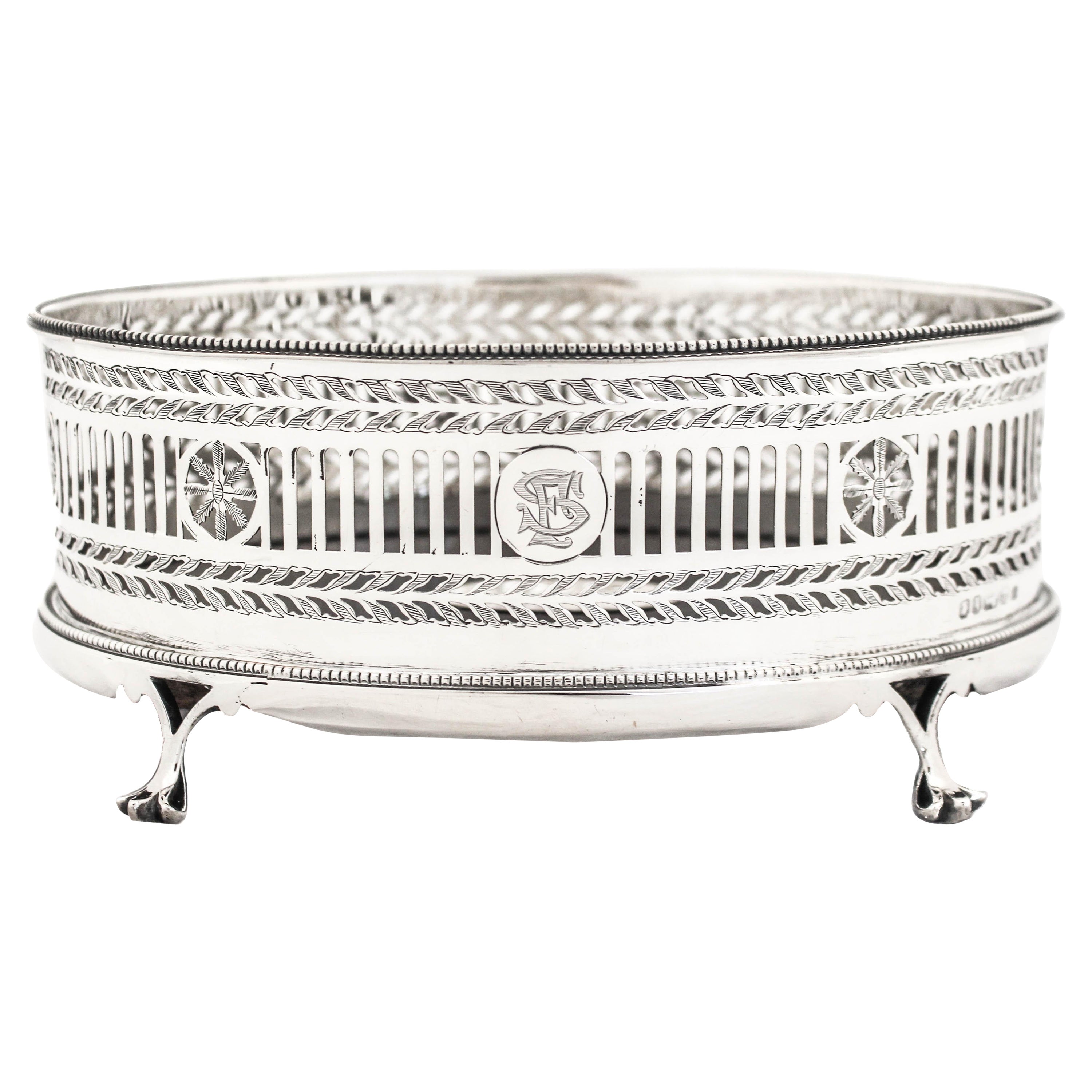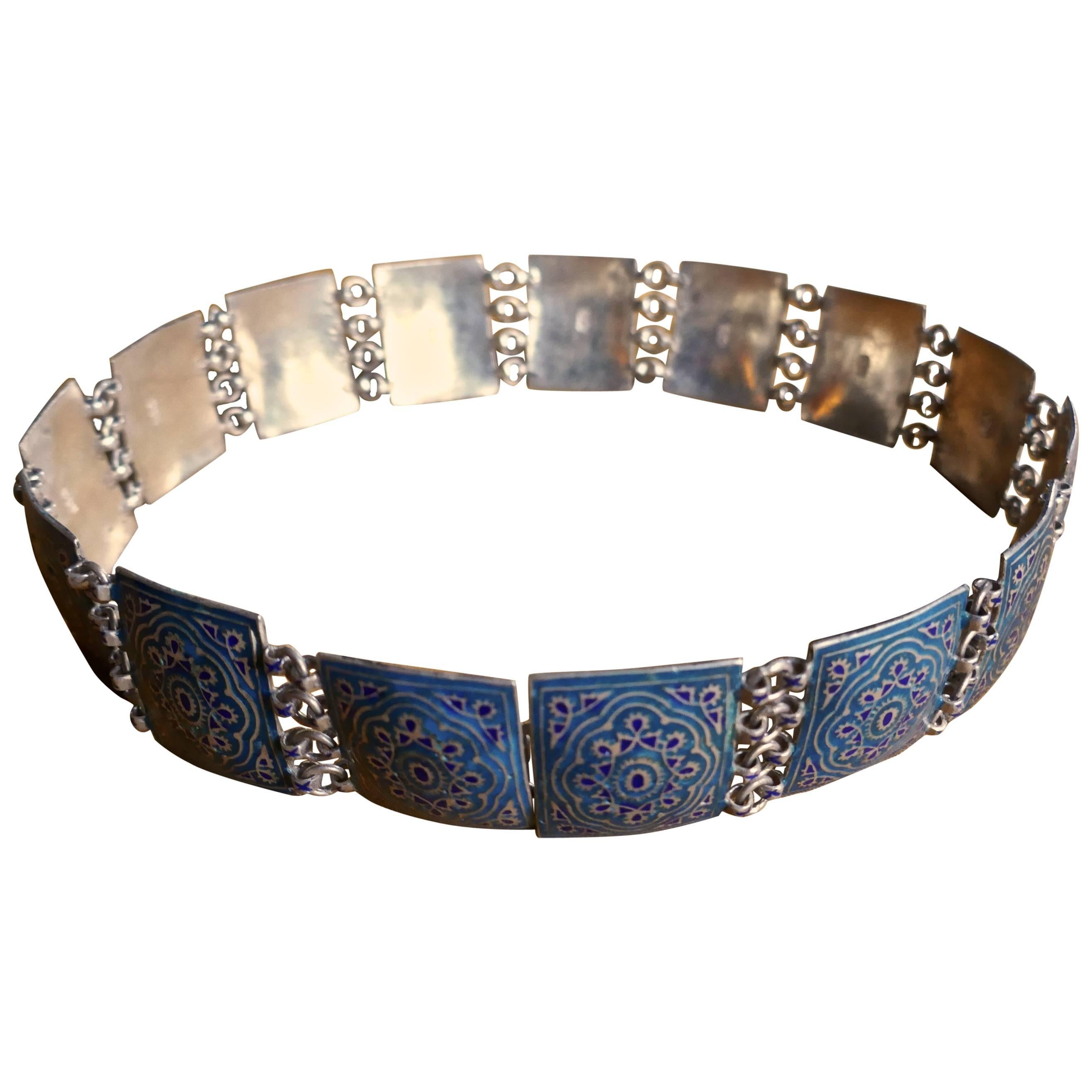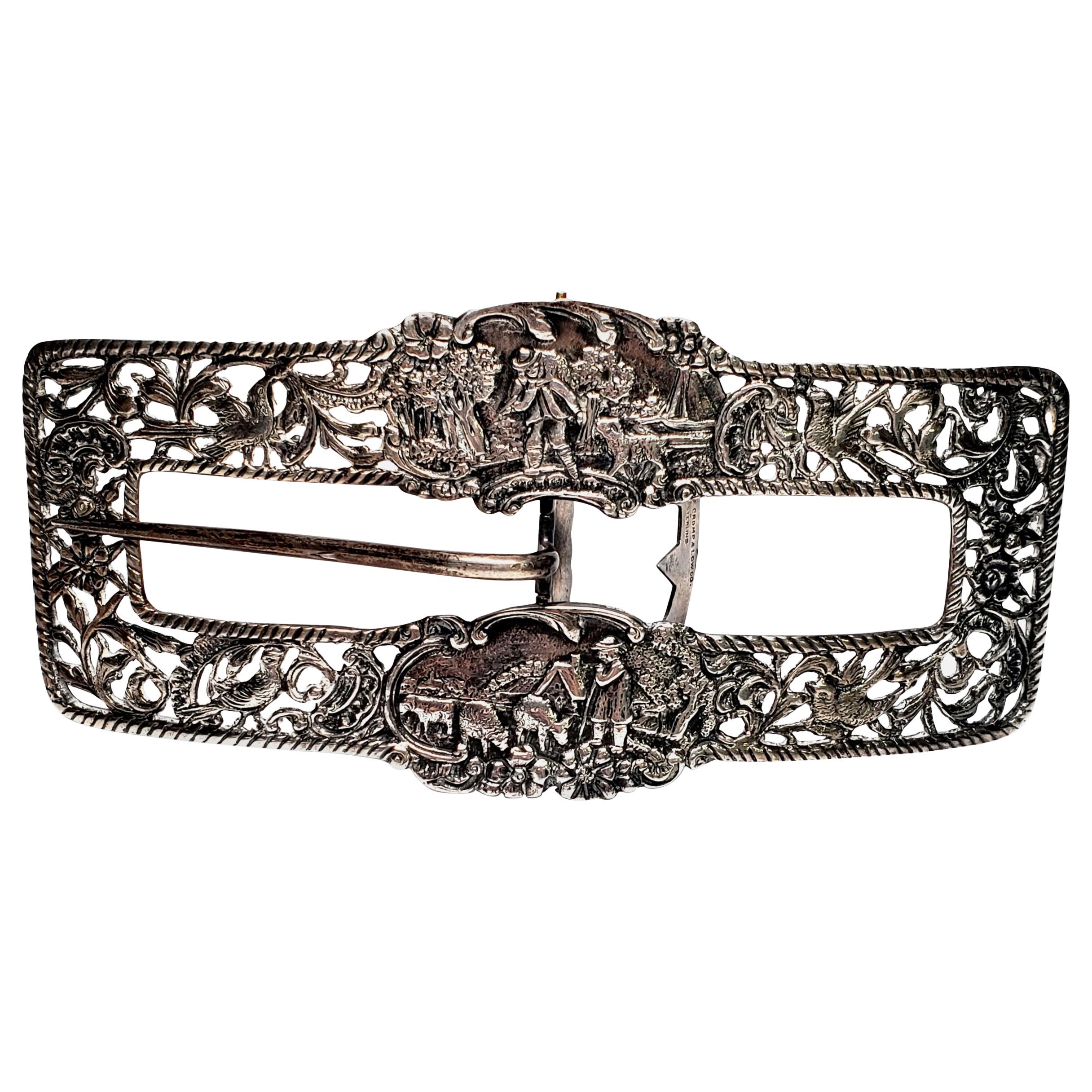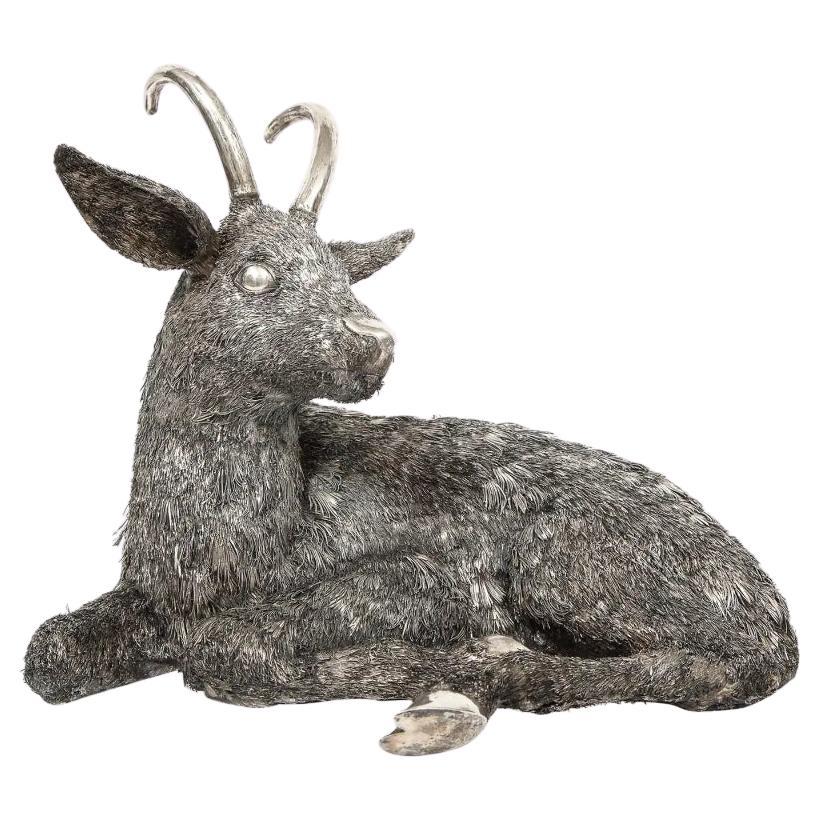Items Similar to Important and rare jewish silver Sivlonot /wedding belt, Frankfurt 1707-1723
Want more images or videos?
Request additional images or videos from the seller
1 of 19
Important and rare jewish silver Sivlonot /wedding belt, Frankfurt 1707-1723
About the Item
Important and rare Sivlonot belt, gilded silver, made by the famous silversmith Johann Mathias Sandrat active in 1707-1723 in Frankfurt, Germany. this JUDAICA object is a museum piece and An almost identical belt with a replaced buckle is exhibited in the Israel museum and came from the important Feuchtwanger Collection, purchased and donated by Baruch and Ruth Rappaport, Geneva.
the belt also bears 2 Christies auction stickers with the number 120, probably lot # 120, indicating it was sold in one of their auction rooms at some point.
Sivlonot (wedding) belt:
In Rabbinic literature, sivlonot refers to gifts the groom gave his wife-to-be. Among German Jews, from the 16th century on, sivlonot took the form of belts: the groom sent his bride a belt with a gold buckle; she sent him a belt with a silver buckle. The couple would then wear the belts under the huppah, sometimes attaching them by means of another belt or a chain. Sivlonot belts were often decorated with universal symbols of love, such as two intertwined hands holding a heart, or the portraits of a man and woman.
length of the belt is : 36 inch
widest point of the buckle : 2.7 inch
belt width : 1.2 inch
Frankfurt jewish community:
The beginnings of Jewish life in Frankfurt am Main date back to the twelfth century, when the first community settled in the area around where the cathedral now stands. But the pogroms of 1241 and 1349 put an end to this period of Jewish life in the city. In 1360 Jewish families returned, when the Jewish Code of Residence (Stättigkeit) once again granted them the right to settle here.
In 1464 the city’s Jews were allocated an area on the edge of the city, where later the Judengasse, or Frankfurt ghetto, emerged. With the exception of the two-year Fettmilch Rising between 1614 and 1616, this was where the city’s Jews remained until emancipation. In 1846, Jews were granted equal rights and gradually relocated to other areas of Frankfurt.
By 1933, the Jewish Community in Frankfurt numbered more than 30,000 members, the majority of them organised in the Israelite community. In 1804 the new Philanthropin schoolhouse was founded, and the Jewish Community in Frankfurt became a centre of religious reform.
In a counter-movement, Rabbi Samson Raphael Hirsch led the formation of the secessionist orthodox community, which banded together to form the Israelite Religious Society in 1848. As well as numerous smaller places of worship, there was the main synagogue in the Jewish Quarter, another at Börneplatz, a third in the Friedberger Anlage, built in 1907 for the secessionist orthodox community, and the liberal Westend Synagogue, built in 1910. The Jewish Community in Frankfurt reflected the open-mindedness of the city.
Numerous members of the Jewish Community took on prominent roles in the cultural and political life of Frankfurt, with many institutions growing from Jewish foundations or established by Jewish citizens, such as the Johann Wolfgang von Goethe University and Frankfurter Zeitung newspaper, predecessor of the Frankfurter Allgemeine Zeitung. Frankfurt has also been home to several famous rabbis of the various religious groups, including Samson Raphael Hirsch, Markus Horovitz, Nehemia Anton Nobel, Ceasar Seligmann and Georg Salzberger
- Dimensions:Height: 36 in (91.44 cm)Diameter: 2.7 in (6.86 cm)
- Materials and Techniques:
- Place of Origin:
- Period:
- Date of Manufacture:1710
- Condition:Wear consistent with age and use. minor scratches and dents.
- Seller Location:Tel Aviv - Jaffa, IL
- Reference Number:1stDibs: LU8130236074322
About the Seller
No Reviews Yet
Vetted Seller
These experienced sellers undergo a comprehensive evaluation by our team of in-house experts.
1stDibs seller since 2023
- ShippingRetrieving quote...Ships From: Tel Aviv - Jaffa, Israel
- Return PolicyThis item cannot be returned.
More From This SellerView All
- Rare Antique Novelty German silver antler and silver cigar cutter, 1890-1900Located in Tel Aviv - Jaffa, ILVery attractive German silver mounted on an antler, cigar cutter This cigar cutter is designed as oak leaves falling on the antler and in the middle There is a game bird of some kind hung from it, very realistic and well made. This kind of objects were made in Germany and Austria so they can be given as High end gifts, used as a display piece with function in men clubs...Category
Antique 1890s Sterling Silver
MaterialsSilver, Steel
- Rare George iv Gilt-Silver Inkwell, Rundell and BridgeBy Rundell, Bridge & RundellLocated in Tel Aviv - Jaffa, ILVery rare and important piece of George IV silver, highly important silver-gilt Inkwell probably by John Bridge of the renowned silversmiths Rundell & Bridge, Royal Silversmiths to t...Category
Antique 1820s English Sterling Silver
MaterialsGold Plate, Silver
- Important Rothschild family French silver presentation plate by Maurice MayerLocated in Tel Aviv - Jaffa, ILextremely rare french silver presentation plate/ dinner plate. this important plate is one of the best quality work and engraving i have ever seen in my life, the outer rim is all adorned and ornate with flowers in neoclassical style, and the actual plate is all hand engraved with the most incredible engraving with gold plating on just the engraved patterns what makes the plate looks like the gold plated part is 3 dimensional. This important plate was made in paris by the famous silver master Maurice Mayer...Category
Antique Late 19th Century French Neoclassical Sterling Silver
MaterialsGold Plate, Silver
- Important Early 20th Century Silver Kiddush Goblet by Bezalel School JerusalemLocated in Tel Aviv - Jaffa, ILImportant Handmade sterling silver Kiddush goblet by Bezalel School, Jerusalem, circa 1910-1913. On round base decorated with silver filigree and Cabouchon shaped green agate applications. The base fitted with Bezalel mark. The upper portion is all adorned with amazing filigree work, the base and the actual cup adorned with swirling filigree designs, in the middle there are 3 roundels, made in another technique of hammered silver, similar to the works that were produced in this time all over Europe, in the middle of each roundel there is a perfectly centered Cabouchon green agate. This work is attributed to Yehia Yemini. The goblet is marked on the base, with the earliest silver mark of the school that just say "Bezalel" in Hebrew. Yehia Yemini : Was one of the biggest and must famous Bezalel silver...Category
Early 20th Century Israeli Jugendstil Sterling Silver
MaterialsSilver
- Important Early 20th Century Silver Kiddush cup by Bezalel School JerusalemLocated in Tel Aviv - Jaffa, ILImportant Handmade sterling silver Kiddush goblet by Bezalel School, Jerusalem, Circa 1910-1913. On the cup there are 3 identical scenes of flanked lions and on the middle of them There are two columns with a staircase, this design is probably taken from Eastern European torah ark, on the middle part there is a chandelier with 3 tiger/lioness Heads, the top of the cup has 3 inscription on top of each flanking lions scene, first One says : ״כוס ישועות אשא״ (Psalms 116:13) which means " I will take the cup of Salvation", this is a rather common blessing on kiddush cups. Next inscription says : ״אין שמחה אלא ביין״ in English " there is no joy except in wine" This says that after the temple was destroyed we have our joy only in the wine of Kiddish. The last inscription says ״ושמחת בחגך״ (Deuteronomy 16:14 ) in English : "And you shall rejoice in your festival". So this cup is a kiddish cup...Category
Vintage 1910s Israeli Art Nouveau Sterling Silver
MaterialsSilver
- A RARE SILVER SHMIROT KIDDUSH CUP. Galician, c. 1850.Located in Tel Aviv - Jaffa, ILA RARE SILVER SHMIROT KIDDUSH CUP. Galician, c. 1850. Among some Hassidic courts, it was a practice for the Rabbi to give a blessed silver coin to his Hassidim as an amulet. Such protection might be given for all manner of life events, from healing from an illness to success in travel and the amulet was carried on the body of the recipient. This custom was particularly popular among the Ryzhiner Hassidim and these coins were called "Shmirot". To such coins were attributed extraordinary power and value and they were treasured with great care and love. this cup is marked with polish loth 12 mark which indicate silver content of 75%. Size : Height 2.3 inch / 6 cm Width : 2 inch / 5 cm After the specific event for which they had originally be given, such a coin or coins were used in the making of other objects, which maintained the special aura of the Rabbi. Such a coin would be melted in other silver with the amuletic valued being spread evenly to all the silver. Then a ritual object would be fashioned by a silversmith and the special nature of the item would be inscribed on it, indicating in one of several ways that this object had been made from "Shmirot". this objects include Kiddish cups, a Havdalah tray, a Shabbat salt holder, a Chanukkah Menorah, a Torah crown etc. This object is a Kiddish cup fashioned from such silver. On this cup, the inscription indicating Shmirot is found in the abbreviation of the words "made from shmirot k (kodesh)' " (This is the cup of Shmirot). Such cups were used for blessing the wine so that each use renewed the power of protection granted by the Rabbi. This cup was used for the blessing over wine on Shabbat and holidays. Inscription: the other iconography on the cup is of a lion that represent Through the tribe of Judah, the lion symbol came to represent the blessing, majesty, and even divine protection of the Jews. The lion symbol continued to be used even after the destruction of Jerusalem, the capital of Judah's nation, and a unicorn or a re'em, also reëm (Hebrew: רְאֵם), is an animal mentioned nine times in the Hebrew Bible It has been translated as "unicorn" in the Latin Vulgate, King James Version, and in some Christian Bible translations as "oryx" (which was accepted as the referent in Modern Hebrew),[citation needed] "wild ox", "wild bull", "buffalo" or "rhinoceros". Rabbi Natan Slifkin has argued that the re'em was an aurochs, as has Isaac Asimov...Category
Antique 1850s Sterling Silver
MaterialsSilver
You May Also Like
- Rare & Important Pair of 18th Century Georgian Sterling Silver Ice Cream ShovelsBy Richard CrossleyLocated in Ottawa, OntarioAn extremely rare & important pair of 18th century George III sterling silver ice cream shovels / spades. Both cast in the Fiddle & Thread pattern, ...Category
Antique Late 18th Century English George III Sterling Silver
MaterialsSterling Silver
- Antique Traditional Armenian Ladies Silver and Niello BeltLocated in Braintree, GBAntique traditional Armenian ladies silver and niello belt Made in Imperial Russia, possibly Caucasus region (Armenia) Made 1897-1910 Maker: ?? (Cyrilli...Category
Antique 1890s Armenian Sterling Silver
MaterialsSilver
- Rare Sterling SilverBy Atkins BrothersLocated in Brooklyn, NYWe are delighted to offer you this exceptional sterling silver (tea) tray, made by Harry Atkin (Atkin Brothers) of Sheffield England, hallmarked 1903. This antique tray was manufact...Category
Antique Early 1900s English Sterling Silver
MaterialsSterling Silver
- Art Deco Silver Enamel BeltLocated in Chillerton, Isle of WightArt Deco Russian silver enamel belt This is a lovely silver enamel belt it dates from 1910 and is made with rectangular silver enamelled medallions, these have a design in turquoi...Category
Early 20th Century Russian Folk Art Sterling Silver
MaterialsSilver
- Shreve Crump and Low Sterling Silver Large Belt BuckleLocated in Washington Depot, CTVintage large sterling silver belt buckle. Intricately detailed farm scene framed with birds, leaves and flowers. Measures 6 1/2" x 3" Weighs 123g, 79.1dwt. Marked SHREVE...Category
20th Century Unknown Sterling Silver
MaterialsSterling Silver
- Mario Buccellati, a Rare and Exceptional Italian Silver GoatBy Mario BuccellatiLocated in New York, NYMario Buccellati, a rare and exceptional Italian silver goat circa 1940. Made in Milan Italy. Very fine quality and workmanship and very large in size. Measures: 12" high x 14" w...Category
20th Century Italian Animal Sculptures
MaterialsSilver
Recently Viewed
View AllMore Ways To Browse
Square Silver Salver
Antique Mask Collection
Silver Black Starr And Frost Bowl
Keswick School Of Industrial Art
Woodman Table
Mens Briefcase Trunk
The Federalist Furniture
Curved Server
Silver 1935
Silver Cup Handle Hallmarked
Hayes And Mcfarland
Old Colonial Silver Pattern
Antique Sterling Vanity Set
Grande Regency By International Sterling Silver
H Nils Sterling Silver
John Wendt Moresque
Kalo Bowl
Kirk Florentine





